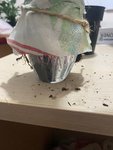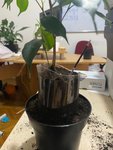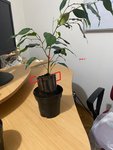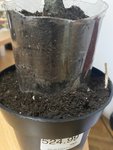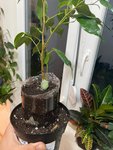walawelo
Sapling
Hello Everyone, I have been dabbling with root over rock noob experiments (over 20). I say experiments because I wont find out if I succeeded till next year  . I have been watching some amazing threads on this forum and I have tried to watch every video there is about root over rock and exposed roots bonsai. I have noticed that it has been done on quartzite, quartz but never on glass. I decided to try root over glass using this glass paper weight and a Ficus Benjamina cutting that I rooted end of 2019 after pruning my indoor tree (not bonsai 1.8 m tree). I know how to care for Benjamina as house plant well for years as I root and gift cuttings often. this species of ficus is known for woody bulgy roots which I think makes it perfect for this experiment as I need it to completely trap the smooth glass inside its roots. First, I rinsed the substrate, then mounted it on the glass using tiny pit of clay from garden to glue it upright. I arranged the roots to cover all sides of the glass and wrapped it tightly with a piece of cotton kitchen cloth, then tied all with organic twine so that no fine roots will grow horizontally. I encased the wrapped glass in a cut piece of plastic soda bottle and planted. I had to use something very thin to get the substrate to cover around the glass, I improvised.
. I have been watching some amazing threads on this forum and I have tried to watch every video there is about root over rock and exposed roots bonsai. I have noticed that it has been done on quartzite, quartz but never on glass. I decided to try root over glass using this glass paper weight and a Ficus Benjamina cutting that I rooted end of 2019 after pruning my indoor tree (not bonsai 1.8 m tree). I know how to care for Benjamina as house plant well for years as I root and gift cuttings often. this species of ficus is known for woody bulgy roots which I think makes it perfect for this experiment as I need it to completely trap the smooth glass inside its roots. First, I rinsed the substrate, then mounted it on the glass using tiny pit of clay from garden to glue it upright. I arranged the roots to cover all sides of the glass and wrapped it tightly with a piece of cotton kitchen cloth, then tied all with organic twine so that no fine roots will grow horizontally. I encased the wrapped glass in a cut piece of plastic soda bottle and planted. I had to use something very thin to get the substrate to cover around the glass, I improvised.
I plan to cut it as indicated next year and expose half of the glass, then the other half on year 3 at which point I plant to repot in a bonsai pot and substrate. The plant is kept outside all summer and brought inside near the window in winter. wish me luck, if it dies its no biggie
I plan to cut it as indicated next year and expose half of the glass, then the other half on year 3 at which point I plant to repot in a bonsai pot and substrate. The plant is kept outside all summer and brought inside near the window in winter. wish me luck, if it dies its no biggie
Attachments
-
 ef3d0de7-a1ca-43f0-b178-a5c691cf926c.jpg114 KB · Views: 49
ef3d0de7-a1ca-43f0-b178-a5c691cf926c.jpg114 KB · Views: 49 -
 62603f9d-9eff-4141-beb4-94558bf22d2f.jpg143.4 KB · Views: 48
62603f9d-9eff-4141-beb4-94558bf22d2f.jpg143.4 KB · Views: 48 -
 4bd1089e-d286-477c-b540-076ecb669bc3.jpg137.4 KB · Views: 46
4bd1089e-d286-477c-b540-076ecb669bc3.jpg137.4 KB · Views: 46 -
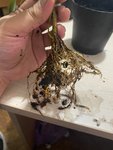 1b7c16ff-3183-475f-b896-52cd200c5928.jpg140.4 KB · Views: 42
1b7c16ff-3183-475f-b896-52cd200c5928.jpg140.4 KB · Views: 42 -
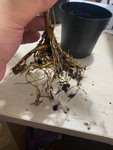 40e5bfed-20a6-4bba-b7ac-de72865e69d6.jpg129.4 KB · Views: 44
40e5bfed-20a6-4bba-b7ac-de72865e69d6.jpg129.4 KB · Views: 44 -
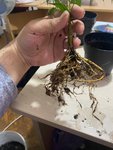 b7e6a74c-9fe4-4ad5-aa98-8e21844e803d.jpg154.8 KB · Views: 45
b7e6a74c-9fe4-4ad5-aa98-8e21844e803d.jpg154.8 KB · Views: 45 -
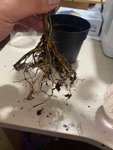 f19e1560-d3a9-4852-b814-e39477bda220.jpg127 KB · Views: 44
f19e1560-d3a9-4852-b814-e39477bda220.jpg127 KB · Views: 44 -
 36cad752-e3c0-4a88-8976-f08882f3fa73.jpg127 KB · Views: 43
36cad752-e3c0-4a88-8976-f08882f3fa73.jpg127 KB · Views: 43 -
 f8e71147-1a3f-4e14-af9f-c0ddc7c16bf4.jpg131.2 KB · Views: 45
f8e71147-1a3f-4e14-af9f-c0ddc7c16bf4.jpg131.2 KB · Views: 45 -
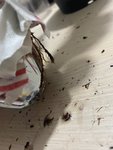 a0a92e4a-586a-4202-b36d-add66565af3b.jpg135.7 KB · Views: 46
a0a92e4a-586a-4202-b36d-add66565af3b.jpg135.7 KB · Views: 46

